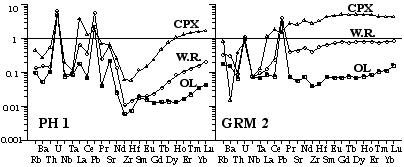Uranium enrichment in the lithospheric mantle: Case studies from French Massif Central
O. Alard, GEMOC Maquarie, J.L. Bodinier, X. Lenoir, J.M. Dautria : UMR 5569, Géofluides-Bassins-Eau, ISTEEM, cc 057, Université de Montpellier II, France.
Mantle xenoliths are often enriched in large ion lithophile elements (LILE) relative to heavy REE. This feature is classically attributed to enrichment by melts/fluids infiltrated into the lithosphere. Moreover several recent papers have reported peridotite from world-wide continental occurrences characterized by selective U and Pb ± Sr enrichment (e.g., Jochum et al., 1989; Ionov et al., 1995). However current interpretations of selective U enrichment in mantle xenoliths call upon post-eruption alteration involving U- and Pb-rich fluids.
Our ICP-MS study of a large number of mantle xenoliths collected in
various localities from French Massif Central confirms the widespread distribution
of U-rich peridotites on the scale of this region (e.g., Alard et al.,
1996). Virtually all the analyzed samples are selectively enriched in uranium
with U/ThPM ratios as high as 60 in several samples. It is worthnoting
that U- and Pb-rich xenoliths include peridotites which are otherwise depleted
in highly incompatible elements, with compositions typical of unmetasomatized
"Depleted MORB Mantle". The only noticeable exceptions are xenoliths characterized
by overall enrichment of LILE and negative anomaly of high field strengh
elements, a signature which is commonly ascribed to mantle metasomatism
by carbonate-rich melts; they display a normalised U/Th ratio close to
1. Similar to the results obtained by Ionov et al., 1995, our data indicate
that U/Th fractionation is roughly coupled with Pb/Ce and Sr/Ce positive
fractionation. These correlations show that the fractionation of U, Pb
and Sr over Th and Ce, respectively, are linked together and are probably
the result of the same process. In individual xenolith suites, U/Th and
Pb/Ce ratio are well correlated with LREE/MREE.

figure 1: Pb/Ce and Sr/Ce versus U/Th for French Massif Central xenoliths, n-PM: normalised to primitive mantle.
Separated and leached Cpx and olivine were analysed from several typical
samples (fig. 2). U/ThPM for all the cpx fractions, ranges
from 1.6 to 10.4. and Pb/CePM is generally lower than 2. These fractionations
are significantly lower than those observed in the whole rock and the U,
Pb and Sr contents of cpx are not high enough to account to the whole rock
budget. However the cpx U/Th and Pb/Ce ratios display a positive correlation
with the whole rock ratio. Nevertheless, all olivine fractions show U and
Pb positive anomalies, U/ThPM ranges from 12.6 to 66.4 and Pb/CePM from
33 to 120 and have U/ThPM ratios always very close to the whole rock ratio.
This suggests, that the whole rock U/Th and Pb/Ce are mainly controlled
by the olivine.

Fig. 2. Cpx, whole rock and olivine trace element content normalised to Primitive mantle.
In contrast with the conclusions of previous studies, our data indicate that the selective enrichment of uranium in mantle xenoliths is of primary origin. This is shown by (1) the absence of detectable alteration products in the studied samples, (2) the low U/Th values of the host lavas (Å primitive mantle values), (3) the fact that the elevated U/Th and Pb/Ce values of bulk rocks are also observed in separated minerals (olivine, cpx) analyzed after extensive acid-leaching (roughly estimated more than 75 % of the U is enclosed within the primary minerals and especially in the olivine) (4) the absence of marked U anomaly in the samples affected by "carbonate-melt" metasomatism. Our data suggest that the U anomaly is not just overwhelmed by overall LILE but more likely erased.
On the basis of our results, we suggest that a considerable proportion of the subcontinental lithospheric mantle is characterized by U/ThPM ratios much higher than the primitive mantle value. Our data for acid-leached olivine separates and leaches indicate that fluid inclusions trapped in minerals have elevated U/Th values. Together with experimental evidence (Brenan et al., 1995), this observation is consistent with uranium enrichment by water-rich small melt fractions (± Sr and LREE). These fluids might be derived from subduction processes, or they may represent evolved liquids resulting from melt-rock reactions in the lower lithosphere, above a mantle plume (Bedini et al., 1997). The latter hypothesis is supported by 0D numerical simulation (Vernieres et al., 1997) of reacting porous flow involving partition coefficient of water-rich small volume melts. This results -for the most soluble elements- from coupled chromatographic effect and source effects of reactions at decreasing melt-mass. If time-integrated, this U-enrichment could represent an efficient way to generate enriched isotopic reservoirs.
Alard O., Dautria, J.-M. and Bodinier, J.-L. 1996, C. R. Acad. Sci. Paris, 323, 763-770 .
Bedini R.M., Bodinier, J.-L., Dautria, J.-M. and Morten L. 1997, Earth Planet. Sci. Lett., 153, 67-83.
Brenan, J. M., Shaw, H. F., Ryerson, F. J. and Phinney, D. L., 1995, Geochim. Cosmochim. Acta, 59, 3331-3350.
Ionov D.A., O'Reilly, S.Y. and Aschepkov, I.V. 1995, Chem. Geol., 120, 275-294.
Jochum K.P., McDonough, W.F., Palme, H. and Spettel, B. 1989, Nature, 340, 548-550.
Vernieres J., Godart, M. and Bodinier J.-L. 1997, J. Geophys. Res., 102 B11, 24,771-24,784.

 GEMOC ARC National Key Centre
GEMOC ARC National Key Centre